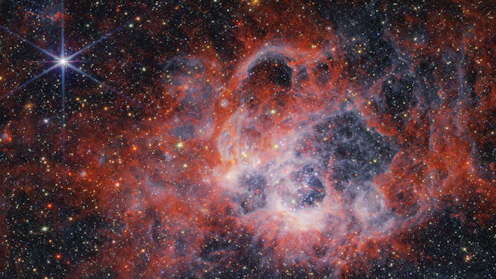How can the James Webb Space Telescope see so far?
- Written by Adi Foord, Assistant Professor of Astronomy and Astrophysics, University of Maryland, Baltimore County

Although the human eye cannot see it, people can detect infrared light as a form of heat using specialized technology, such as infrared cameras or thermal sensors. For example, night-vision goggles use infrared light to detect warm objects in the dark. Webb uses the same idea to study stars, galaxies and planets.
Why infrared? When visible light from faraway galaxies travels across the universe, it stretches out[7]. This is because the universe is expanding[8]. That stretching turns visible light into infrared light. So, the most distant galaxies in space don’t shine in visible light anymore – they glow in faint infrared. That’s the light Webb is built to detect.
A golden mirror to gather the faintest glow
Before the light reaches the cameras, it first has to be collected by the Webb telescope’s enormous golden mirror[11]. This mirror is over 21 feet (6.5 meters) wide and made of 18 smaller mirror pieces that fit together like a honeycomb. It’s coated in a thin layer of real gold – not just to look fancy, but because gold reflects infrared light extremely well.
The mirror gathers light from deep space and reflects it into the telescope’s instruments. The bigger the mirror[12], the more light it can collect – and the farther it can see. Webb’s mirror is the largest ever launched into space.
Inside the cameras: NIRCam and MIRI
The most important “eyes” of the telescope are two science instruments that act like cameras: NIRCam and MIRI.
NIRCam stands for near-infrared camera. It’s the primary camera on Webb and takes stunning images of galaxies and stars. It also has a coronagraph[13] – a device that blocks out starlight so it can photograph very faint objects near bright sources, such as planets orbiting bright stars.
NIRCam works by imaging near-infrared light[14], the type closest to what human eyes can almost see, and splitting it into different wavelengths. This helps scientists learn not just what something looks like but what it’s made of. Different materials in space absorb and emit infrared light at specific wavelengths, creating a kind of unique chemical fingerprint[15]. By studying these fingerprints, scientists can uncover the properties of distant stars and galaxies.
MIRI, or the mid-infrared instrument, detects longer infrared wavelengths[16], which are especially useful for spotting cooler and dustier objects, such as stars that are still forming inside clouds of gas. MIRI can even help find clues about the types of molecules in the atmospheres of planets that might support life[17].
Both cameras are far more sensitive than the standard cameras used on Earth. NIRCam and MIRI can detect the tiniest amounts of heat from billions of light-years away. If you had Webb’s NIRCam as your eyes, you could see the heat from a bumblebee on the Moon. That’s how sensitive it is.
Because Webb is trying to detect faint heat from faraway objects, it needs to keep itself as cold as possible. That’s why it carries a giant sun shield about the size of a tennis court[18]. This five-layer sun shield blocks heat from the Sun, Earth and even the Moon, helping Webb stay incredibly cold: around -370 degrees F (-223 degrees C).
MIRI needs to be even colder. It has its own special refrigerator, called a cryocooler, to keep it chilled to nearly -447 degrees F (-266 degrees C). If Webb were even a little warm, its own heat would drown out the distant signals it’s trying to detect.
Turning space light into pictures
Once light reaches the Webb telescope’s cameras, it hits sensors called detectors. These detectors[19] don’t capture regular photos like a phone camera. Instead, they convert the incoming infrared light into digital data. That data is then sent back to Earth, where scientists process it into full-color images[20].
The colors we see in Webb’s pictures aren’t what the camera “sees” directly. Because infrared light is invisible, scientists assign colors to different wavelengths to help us understand what’s in the image. These processed images help show the structure, age and composition of galaxies, stars and more.
By using a giant mirror to collect invisible infrared light and sending it to super-cold cameras, Webb lets us see galaxies that formed just after the universe began.
Hello, curious kids! Do you have a question you’d like an expert to answer? Ask an adult to send your question to CuriousKidsUS@theconversation.com[21]. Please tell us your name, age and the city where you live.
And since curiosity has no age limit – adults, let us know what you’re wondering, too. We won’t be able to answer every question, but we will do our best.
References
- ^ Curious Kids (theconversation.com)
- ^ CuriousKidsUS@theconversation.com (theconversation.com)
- ^ 13 billion years ago (science.nasa.gov)
- ^ December 2021 (science.nasa.gov)
- ^ I’m an astrophysicist (scholar.google.com)
- ^ infrared light (science.nasa.gov)
- ^ it stretches out (www.skyatnightmagazine.com)
- ^ universe is expanding (theconversation.com)
- ^ Inductiveload, NASA/Wikimedia Commons (en.wikipedia.org)
- ^ CC BY-SA (creativecommons.org)
- ^ enormous golden mirror (www.nasa.gov)
- ^ bigger the mirror (theconversation.com)
- ^ a coronagraph (www.space.com)
- ^ NIRCam works by imaging near-infrared light (science.nasa.gov)
- ^ chemical fingerprint (theconversation.com)
- ^ detects longer infrared wavelengths (science.nasa.gov)
- ^ planets that might support life (theconversation.com)
- ^ a giant sun shield about the size of a tennis court (science.nasa.gov)
- ^ These detectors (science.nasa.gov)
- ^ full-color images (theconversation.com)
- ^ CuriousKidsUS@theconversation.com (theconversation.com)
Authors: Adi Foord, Assistant Professor of Astronomy and Astrophysics, University of Maryland, Baltimore County
Read more https://theconversation.com/how-can-the-james-webb-space-telescope-see-so-far-257421

